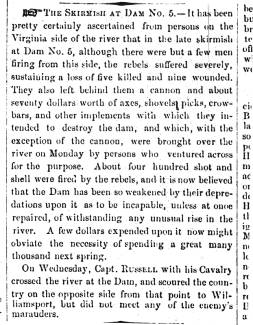Collection Name
About
THE SKIRMISH AT DAM NO. 5.—
It has been pretty certainly ascertained from persons on the Virginia side of the river that in the late skirmish at Dam No. 5. although there were but a few men firing from this side, the rebels suffered severely, sustaining a loss of five killed and nine wounded. They also left behind them a cannon and about seventy dollars worth of axes, shovels, picks crowbars, and other implements with which they intended to destroy the dam, and which, with the exception of the cannon, were brought over the river on Monday by persons who ventured across for the purpose. About four hundred shot and shell were fired by the rebels, and it is now believed that the Dam has been so weakened by their depredations upon it as to be incapable, unless at once repaired, of withstanding any unusual rise in the river. A few dollars expended upon it now might obviate the necessity of spending a great many thousand next spring.
On Wednesday, Capt. RUSSELL with his Cavalry crossed the river at the Dam, and scoured the country on the opposite side from that point to Williamsport, but did not meet any of the enemy's marauders.
The Chesapeake & Ohio Canal played a role in the Civil War as a boundary and route of transportation by the Federal Government. The canal at the beginning of the war was still used as a transportation route of flour and other staples from Western Maryland and Southern Pennsylvania to Washington, D.C. However, after the hostilities began the flour trade, which had started to shift to rail transportation instead of canal, left the canal permanently because of the unpredictability of open transportation because of raids by confederates on the canal. As the battle front moved south into Virginia the canal resumed trade and became one of the main sources of Maryland coal transportation to Washington, D. C. This coal was used to power boat navigation, textile mills, and iron furnaces that would fuel the war effort. The C&O Canal was also used as a transportation route for both the Federal and Confederate armies. Confederate Raiders would use the towpath as a highway on their forays across the Potomac River into Maryland to disrupt the transportation of supplies, by both canal and rail, to Washington.
